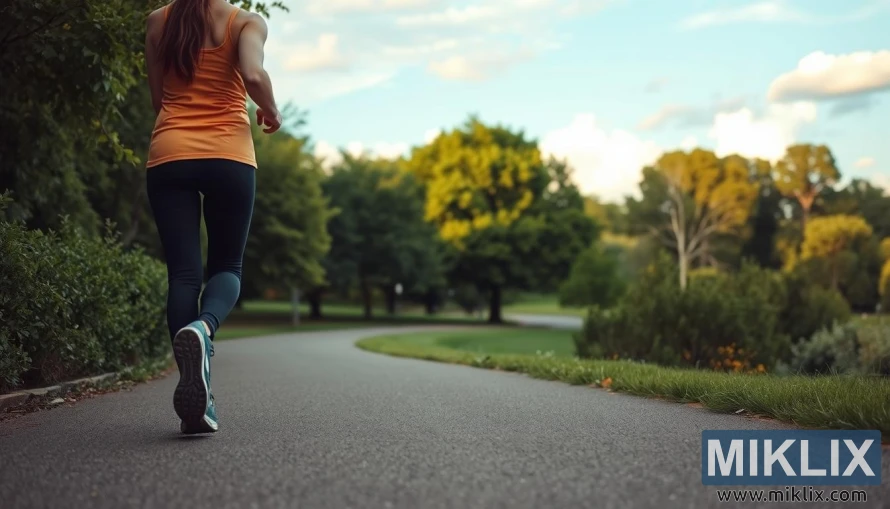Why Walking Might Be the Best Exercise You’re Not Doing Enough
Published: March 27, 2025 at 9:54:52 PM UTC
Last updated: March 28, 2025 at 3:16:28 PM UTC
Walking, a simple form of exercise, offers numerous health benefits that can greatly improve your life. This low-impact activity enhances cardiovascular health and boosts emotional well-being. It requires minimal preparation, making it an accessible way to enhance your health through walking. Studies show that brisk walking, even in short periods, meets weekly physical activity goals. Walking aids in weight management and improves cognitive functions and emotional stability. These benefits are extensive and essential for a healthy lifestyle.
Key Takeaways
- Brisk walking enhances stamina and helps burn calories.
- Just a 10-minute daily walk can contribute to recommended exercise goals.
- Walking promotes weight management and lowers chronic disease risks.
- A regular walking routine can improve mental health and memory.
- Walking strengthens bones and helps prevent osteoporosis.
Introduction to the Benefits of Walking
Walking is a fundamental exercise that offers various health improvements and serves as an accessible entry point to better fitness. It helps maintain a healthy weight and facilitates weight loss. Regular brisk walking can prevent or manage health conditions like heart disease, stroke, high blood pressure, cancer, and type 2 diabetes. It also improves cardiovascular fitness and muscle endurance.
Adding brisk walking to your routine can strengthen bones and muscles. It also improves mood, cognition, memory, and sleep quality. During walks, stress and tension often diminish, leading to enhanced emotional well-being. Many individuals notice that the more they walk—faster, farther, and more frequently—the greater the health benefits they experience.
Interval training, which combines periods of brisk walking with leisurely strolls, is effective for cardiovascular fitness and calorie burn. The U.S. Department of Health and Human Services suggests that adults engage in at least 150 minutes of moderate aerobic activity or 75 minutes of vigorous activity weekly. Walking is an excellent option for this.
Incorporating stretching post-walk can enhance flexibility and minimize injury risk. Walking fosters mindfulness, drawing attention to one's surroundings and boosting psychological benefits. Practices such as Buddhist walking meditation highlight how focusing on movement can reduce blood pressure and alleviate depression. Nature walks, through forests or along rivers, decrease negative emotions like anxiety, fatigue, and confusion. Embracing walking as a form of exercise can yield substantial health improvements, making it a key aspect of any wellness routine.
Understanding the Importance of Regular Physical Activity
Regular physical activity is vital for maintaining health and well-being. Activities like walking offer numerous benefits, making them a practical choice. Walking is a form of moderate aerobic activity that aids in weight control by burning calories. By adding regular activity to your routine, you can lower the risk of heart disease, stroke, and conditions like metabolic syndrome and type 2 diabetes. It also boosts mental health, reducing depression and anxiety symptoms while improving mood through brain chemicals.
Regular activity also improves muscle strength and endurance, boosting energy levels. Many find walking enhances sleep quality, leading to quicker sleep onset and deeper rest. It can also positively impact sexual health, increasing energy and confidence, and aiding arousal and erectile function.
Walking can be a social activity, allowing for connections with friends and family in a healthy setting. It improves cognitive function, benefiting both children and adults. Regular walking aids in weight management by accelerating calorie burn and improving metabolism. Studies show walking for about 150 minutes weekly can significantly reduce health risks.
In conclusion, the significance of exercise cannot be overstated. With walking's numerous benefits, it's encouraged as a simple yet effective way to improve health.
Walking: A Simple Path to Fitness
Walking is a straightforward exercise that boosts fitness without the need for costly equipment or complex training. Most individuals already walk between 3,000 and 4,000 steps daily, setting a foundation for regular activity. By integrating walking into your routine, you can dramatically enhance your physical health.
Studies show that regular walking offers numerous health advantages. It increases oxygen intake and strengthens the heart, improving circulation and lowering blood pressure. Gentle movements also slow arthritis progression, maintain bone density, and tone muscles.
Walking benefits not just the body but also the mind and emotions. Those who walk regularly report less stress, better moods, and improved sleep. Walking can make you feel younger and more vibrant, positively impacting your life outlook.
For beginners or those with health concerns, it's wise to consult a doctor before starting. Essential gear includes supportive, comfortable shoes. A good walking routine includes a 5-minute warm-up, 15 minutes of brisk walking, proper posture, and arm swings. Finish with a cool-down and gentle stretching.
Walking 3-4 times a week allows for gradual increases in duration and intensity. This approach builds endurance without overtaxing the body. Staying hydrated is key; drink a pint of water before and after walking, and sip water every 20 minutes during.
Using a pedometer or fitness tracker can boost motivation, turning walking into a measurable goal. With consistent effort, this simple routine can lead to substantial improvements in both physical and mental health.
Cardiovascular Health and Walking
Regular walking boosts cardiovascular health significantly. It not only promotes a healthier lifestyle but also lowers the risk of heart disease and stroke. Studies show that walking at least 30 minutes daily can greatly improve heart health. Walking helps lower LDL cholesterol, improves circulation, and manages blood pressure effectively.
Moderate walking, like achieving 4,000 steps daily, also offers cardiovascular benefits. This activity prevents weight gain, a key factor in maintaining heart health. It also helps manage hypertension and diabetes, which are risk factors for cardiovascular diseases.
For those with heart conditions, walking is safe and strengthens the heart muscle. It also reduces the risk of cardiovascular events. Observational studies link increased walking with a lower risk of cardiovascular disease. A meta-analysis found walking 30 minutes daily, five days a week, reduces coronary heart disease risk by 19%.
The benefits of walking apply to all ages, from the young to the elderly. Pedometer-based programs increase walking levels, encouraging physical activity. Incorporating walking into daily routines, like commuting, supports heart health and promotes an active lifestyle.
Weight Management Through Walking
Walking is a powerful tool for managing weight and losing pounds. Regular walking helps create a calorie deficit, which is key for weight loss. Studies also show that walking after meals helps control blood sugar levels, improving overall health.
The Mayo Clinic advises walking for 45 minutes to an hour, five or six times a week, for substantial weight loss. For those with busy lives, breaking walks into smaller sessions throughout the day is beneficial. Using a smartphone or wearable device to track steps boosts motivation and accountability in your weight management journey.
To increase the intensity of your walks, try walking uphill or using interval training. Adding arm movements can also increase calorie burn. Focus on consistency, not strictly monitoring calories or distance, for sustainable progress.
Begin with a moderate pace and wear comfortable shoes to enjoy and benefit from walking. Walking at a brisk pace for 30 minutes can burn about 150 calories, aiding in weight management. This contributes to your overall calorie expenditure.
Walking also helps preserve lean muscle mass, which boosts your metabolic rate and aids in maintaining weight. It reduces belly fat, lowering the risk of health issues linked to excess weight. Research indicates that 94% of successful weight maintainers include walking in their daily routine.
The Department of Health and Human Services recommends at least 150 minutes of moderate aerobic activity weekly. Even small amounts of physical activity contribute to weight management and enhance overall well-being. Pairing walking with a balanced diet rich in fruits, vegetables, and whole grains will further support your weight management goals.
Cognitive Benefits of Walking
Walking significantly boosts cognitive functions, improving brain health and mental acuity. Outdoor walking, in particular, has a profound effect on cognitive performance. A mere 15 minutes of outdoor walking can enhance the P300 neural response, linked to attention and memory. This is not seen in indoor walks.
Outdoor walkers also show a significant drop in reaction times during cognitive tasks. This improvement links environmental factors directly to cognitive performance. It shows that outdoor settings are more beneficial for mental clarity than walking alone.
Neuroimaging studies reveal that outdoor exercise activates the prefrontal cortex, vital for executive functions. Regular walking, at least 1 mile daily, reduces cognitive impairment risk by 50% as we age. This suggests walking's protective effect on cognitive health.
Walking's benefits extend beyond immediate cognitive function. It increases brain areas' volume, essential for reasoning and problem-solving. Enhanced aerobic fitness from walking is linked to larger hippocampal volumes, aiding memory.
In conclusion, walking is vital for maintaining and improving cognitive functions, shielding against cognitive decline with age. The link between walking and cognition highlights the need for regular walking in daily routines for optimal brain health.
Emotional Well-being and Walking
Walking is a simple yet powerful way to boost mental health. It not only improves mood but also helps manage anxiety and depression. Research shows that walking in nature has a more profound effect on mood than walking in cities. This connection to nature can reduce anxiety and foster a sense of unity.
Walking in sunlight can also enhance mental well-being. Sunlight therapy is effective in treating depression, including non-seasonal types. Walking increases blood flow to the brain, positively affecting the body's stress response system.
Walking with others can amplify these benefits. Social walking reduces negative emotions, lowers depression risk, and boosts self-esteem. Regular walking, even for short periods, can significantly improve mental health.
Strengthening Muscles and Bones
Walking is a fundamental exercise for musculoskeletal health, focusing on bones and muscles. It's a weight-bearing activity that's key for building and keeping bone density. This is critical for avoiding osteoporosis. Walking not only strengthens bones but also boosts muscle endurance.
Adding brisk walking to your daily routine can greatly enhance balance and coordination. This is vital for lowering the risk of falls and fractures, mainly in older adults. Even short brisk walks of 10 minutes can help maintain bone health through regular, moderate exercise.
Walking's benefits go beyond bones, strengthening leg muscles that support and strengthen bones. As a low-impact activity, walking is accessible to people of all ages. It's a key part of reaching the goal of 50 moderate-impact exercises weekly.
Brisk walking, at speeds of 3 to 4 miles per hour, is highly effective for strengthening bones and muscles. It prevents bone loss and increases density, highlighting walking's importance in fitness routines. Regular walking can significantly improve musculoskeletal health over time.
The Role of Walking in Immune Function
Regular walking boosts the immune system, playing a significant role in health and exercise. A 30-45 minute walk mobilizes vital immune cells like natural killer (NK) cells and cytotoxic T cells. These cells are essential in fighting off pathogens. This moderate exercise improves immunosurveillance, helping the body fight infections more effectively.
Walking enhances the circulation of anti-inflammatory cytokines, supporting metabolic health and immune defense. Unlike intense exercise, which can weaken the immune system temporarily, walking consistently reduces the risk of infections. Studies show a 43% decrease in upper respiratory issues over 12 weeks with regular walking.
Walking also improves the circulation of immunoglobulins, boosting mucosal immunity and lowering infection risk. It may even slow down age-related immune decline, helping to combat chronic diseases associated with aging.
Walking stimulates glucose and lipid metabolism, boosting immune function and overall health. Research indicates that a 20-30 minute brisk walk can effectively activate immune cells. This makes walking a critical activity for a strong immune system and overall wellness.
Social Interactions Through Walking
Walking is more than just a form of exercise; it's a powerful social activity. It boosts physical health and strengthens social bonds. Walking with friends or joining group exercise sessions can boost motivation and foster meaningful connections. This communal aspect leads to stronger relationships through frequent meet-ups and casual chats.
Neighborhoods with walkable features, like sidewalks and parks, offer many chances for socializing. Residents can exchange nods or brief conversations, enriching the community. These interactions help combat social isolation, common in urban areas, by fostering a sense of belonging.
Introducing walking meetings into work life can enhance collaboration and creativity. Walking with colleagues in a relaxed setting encourages open dialogue. This approach promotes physical activity and strengthens workplace relationships through meaningful conversations.
The Italian tradition of La Passeggiata, where families and friends stroll together, highlights walking's social benefits. It shows how these interactions build a supportive community. Walking also exposes people to different cultures and experiences, enriching social interactions in diverse societies.
Best Practices for Making Walking Effective
To maximize the benefits of walking, various techniques can enhance your experience and results. Start by maintaining good posture to optimize your body mechanics. Stand tall, engage your core, and swing your arms from your shoulders for efficient movement. Proper footwear is essential; choose shoes that provide adequate support and cushioning.
Warm-ups and cool-downs are integral components. Spend a few minutes walking at a gentle pace before transitioning to brisk walking. After your walk, include stretches that target your calves, hamstrings, and quads to improve flexibility and prevent injuries.
Incorporating varied walking styles enhances both cardiovascular outcomes and motivation. Consider interval training by alternating between brisk walking and jogging. This approach not only increases your heart rate but also adds excitement to your routine. Walking in different environments can enrich your experience; whether in urban settings or beautiful parks, each offers unique benefits.
Engaging with walking tips, such as using light resistance bands or carrying light dumbbells, can help engage more muscle groups. Walking on inclines, whether on hills or treadmills, can further challenge your body and enhance calorie burn. Consistency is key; adapting walking techniques into a daily routine can help develop lasting habits over just a few weeks.
Walking can be a social activity as well. Whether with a friend or a furry companion, sharing the experience can improve motivation and create lasting connections. Enjoying nature can also have psychological benefits, reducing stress and improving mood.
By integrating these walking tips and techniques, you will create a more effective walking routine. This routine promotes not only physical health but also emotional well-being.
Creating a Walking Routine
Creating a consistent walking routine is key to incorporating exercise into daily life. A structured approach boosts overall health and solidifies positive exercise habits. Begin with achievable goals, like walking for 15 minutes daily and increase by 5 minutes weekly. Aim for 150 minutes of walking weekly for health benefits like better joint health, circulation, and mood.
Choosing specific times for walks helps establish a reliable schedule. Early mornings or late afternoons are often ideal for many. Selecting enjoyable routes also boosts routine sustainability. Consider paths in parks, around neighborhoods, or indoor tracks on rainy days. This variety keeps motivation high and prevents boredom.
Technology can enhance your routine. Use apps or gadgets to track progress and celebrate milestones. Overcoming barriers like bad weather or low energy requires flexibility. Adjusting routines by walking indoors or at different times helps maintain consistency.
Focus on good posture and wear comfortable athletic shoes for a better experience. If health conditions exist, consult a doctor before starting. When building a routine, change only one factor at a time for safety and effectiveness. Include rest days to allow for recovery and foster a lasting routine.
Tracking Progress in Walking
Tracking walking activity is key to measuring fitness progress and staying motivated. Fitness trackers and mobile apps help monitor walking miles, steps, duration, and calories burned. This data shows health patterns and guides routine adjustments.
Keeping a journal offers a space for reflecting on physical and emotional progress. It boosts motivation over time. Writing by hand strengthens the mind-body connection, promoting mindfulness and stress relief. Without tracking, achievements may fade, reducing motivation.
Setting a baseline by averaging weekly steps helps set realistic goals. Short-term goals, like adding 1,000 steps daily, support long-term ambitions, such as reaching 10,000 steps. Studies show walking at least 7,000 steps daily can extend life. Walking briskly for at least 30 minutes daily is best for health.
Many activity trackers also measure heart rate and sleep quality, along with steps. This feedback is essential for tracking progress and staying informed. Starting with 10-15 minute walking intervals daily can build lasting habits. Tracking progress sets achievable goals and celebrates improvements, boosting satisfaction and accomplishment.
Finding Motivation for Consistent Walking
Maintaining walking motivation can be a challenge, yet it's essential for a consistent routine. Setting achievable, incremental goals is key to staying committed. For example, aiming for a 30-minute walk after breakfast can create a reliable habit. Walking for 30–45 minutes, five times a week, can significantly lower the risk of premature death from various diseases. This highlights the importance of regular physical activity.
Walking with friends not only boosts exercise motivation but also makes it more enjoyable. Discovering new walking routes or adding fun activities, like square-dancing or Zumba, keeps walks engaging. Listening to music or podcasts during walks can also enhance enjoyment, encouraging you to stay active.
Bad weather can be a barrier to outdoor walking. Planning indoor activities, such as yoga, helps maintain motivation despite external challenges. Even five minutes of walking on low motivation days can lead to a more consistent routine.
Tracking progress through a journal or fitness app is a powerful tool for maintaining motivation. Reflecting on your health and well-being achievements reinforces the benefits of staying active. Focusing on personal values, like spending quality time with family during walks, can deepen your commitment and connection to the activity.
Potential Risks and Considerations in Walking
Walking is often seen as a low-impact exercise, yet there are several risks to be aware of. Uneven surfaces can cause slips and falls, a common source of preventable injuries. Distractions like using cell phones, reading, or carrying too much can also lead to accidents. Rushing or engaging in conversations while walking increases the risk of accidents.
Choosing the right footwear is a key safety consideration. Depending on the environment, wear slip-resistant shoes or steel-toed boots to reduce injury risk. Keeping walkways clear and securing cords while cleaning spills promptly can prevent accidents in public and private areas.
In 2022, 7,522 pedestrians lost their lives in traffic incidents, a rate of one every 70 minutes. Pedestrians should use sidewalks when possible. When crossing streets, always use crosswalks and look in all directions for safety. Avoid areas near driveways and parking lots where vehicles may back up.
Drivers also have a critical role in pedestrian safety. They should drive at safe speeds in areas with pedestrians. Yield to pedestrians at crosswalks and stop well before to ensure visibility. Alcohol and drugs impair both drivers and walkers, significantly increasing accident risks. Older adults and children are more vulnerable and need extra safety measures.
Conclusion
Walking stands out as a versatile and impactful exercise, delivering numerous health benefits. It enhances cardiovascular health, aids in weight management, and boosts cognitive function. It also plays a significant role in emotional well-being. With just 30 minutes of moderate-intensity walking most days, individuals can enjoy this low-impact exercise. It requires no special equipment, making it accessible to all.
Regular walking not only lowers mortality rates but also effectively reduces the risk of cardiovascular diseases. It serves as a natural remedy for improving mental health, alleviating symptoms of depression and anxiety. By creating a manageable walking routine, tracking progress, and setting specific goals, individuals can cultivate a sustainable fitness habit. This habit enriches their lives.
Consider reaching out to friends or joining a walking group for added support. Remember, every step can lead to transformative changes in your health journey. Walking is a powerful choice for better living.
Physical Exercise Disclaimer
This page contains information on one or more forms of physical exercise. Many countries have official recommendations for physical activity that should take precedence over anything you read here. You should never disregard professional advice because of something you read on this website.
Furthermore, the information presented on this page is for informational purposes only. While the author has put reasonable effort into verifying the validity of the information and researching the topics covered here, he or she is possibly not a trained professional with a formal education on the subject matter. Engaging in physical exercise may come with health risks in case of known or unknown medical conditions. You should always consult with your physician or another professional health care provider or professional trainer before making significant changes to your exercise regimen, or if you have any related concerns.
Medical Disclaimer
All content on this website is for informational purposes only and is not intended to be a substitute for professional advice, medical diagnosis, or treatment. None of the information here should be considered medical advice. You are responsible for your own medical care, treatment, and decisions. Always seek the advice of your physician or another qualified healthcare provider with any questions you may have regarding a medical condition or concerns about one. Never disregard professional medical advice or delay seeking it because of something you have read on this website.




